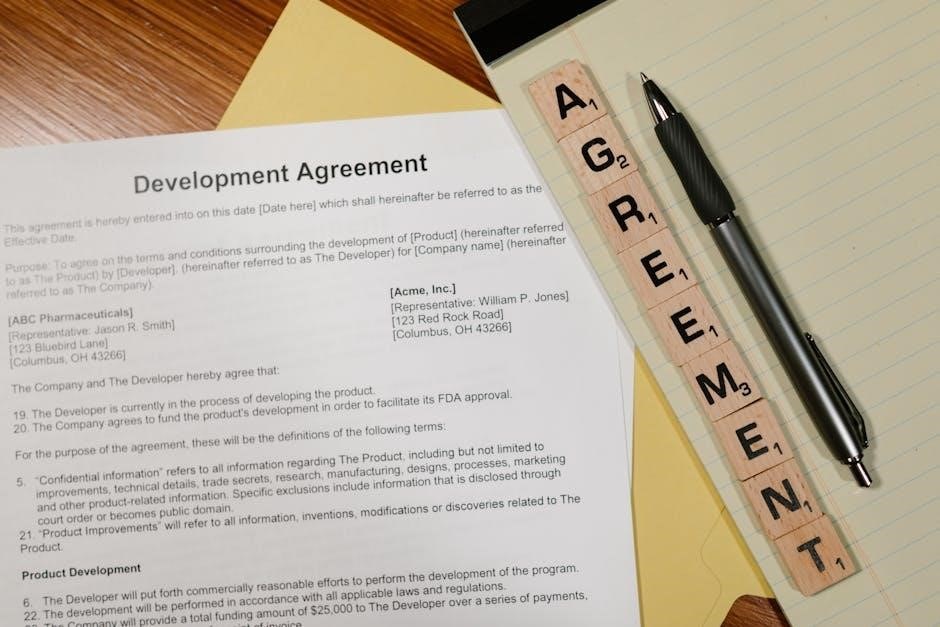A project management glossary is a comprehensive resource providing clear definitions of key terms, ensuring standardized communication. It aids project managers, team members, and stakeholders in understanding essential concepts, tools, and techniques, promoting consistency and efficiency in project execution.
What is a Project?
A project is a temporary endeavor undertaken to create a unique product, service, or result. It has a defined start and end, aiming to achieve specific objectives within constraints like time, budget, and resources. Projects vary in complexity and scope, spanning industries from construction to IT. Their success is measured by delivering intended outcomes, meeting stakeholder expectations, and adhering to predefined goals. Effective project management ensures these objectives are realized efficiently and effectively, aligning with organizational strategies and desired outcomes.
What is Project Management?
Project management is the systematic process of initiating, planning, executing, monitoring, controlling, and closing projects to achieve specific goals. It involves coordinating resources, tasks, and stakeholders to deliver outcomes on time and within budget. Key aspects include scope, time, cost, and quality management. Effective project management ensures alignment with organizational objectives, maximizes efficiency, and minimizes risks, ultimately delivering value to stakeholders through successful project completion and satisfaction of requirements and expectations.
Role of a Project Manager
The project manager is responsible for planning, coordinating, and overseeing project activities to ensure successful completion. They define objectives, allocate resources, and monitor progress. Key duties include risk management, communication, and stakeholder engagement. The manager ensures alignment with organizational goals and delivers expected outcomes on time and within budget, fostering collaboration and addressing challenges to maintain project efficiency and stakeholder satisfaction throughout the lifecycle.

Project Management Processes
Project management processes involve initiating, planning, executing, monitoring, controlling, and closing activities. These structured phases ensure alignment with organizational goals, effective resource allocation, and successful delivery of outcomes.
Initiating
Initiating is the first process in project management, defining the project scope, objectives, and stakeholders. It involves creating a project charter and preliminary scope statement to authorize the project. This phase sets the foundation by identifying key deliverables, success criteria, and high-level risks. Effective initiation ensures alignment with organizational goals and secures necessary resources and commitments, laying the groundwork for successful project execution.
Planning
Planning involves defining project objectives, scope, schedules, budgets, and resource allocation. It includes creating detailed plans for execution, monitoring, and control. Key activities include work breakdown structures, risk management, quality assurance, and communication strategies. Tools like Gantt charts and Critical Path Method (CPM) are used to visualize timelines and dependencies. Effective planning ensures realistic goals, efficient resource use, and alignment with stakeholder expectations, setting a clear roadmap for successful project delivery while addressing potential risks and uncertainties proactively.
Executing
Execution is the phase where the project plan is implemented, and deliverables are created. It involves task execution, resource allocation, and team coordination. The project manager oversees activities, ensures compliance with quality standards, and manages communication. This phase requires active leadership to guide the team, address issues, and maintain progress toward objectives. Effective execution sets the foundation for successful monitoring, controlling, and eventual project closure, ensuring that the project stays on track and meets its intended goals and stakeholder expectations.
Monitoring and Controlling
Monitoring and controlling involve tracking project progress, identifying deviations, and taking corrective actions. This phase ensures the project stays aligned with its goals, timelines, and budget. Key activities include performance measurement, issue management, and adjusting plans as needed. Tools like Gantt charts and earned value management help assess progress and maintain control. Effective monitoring ensures transparency, accountability, and timely interventions, ultimately contributing to successful project delivery and stakeholder satisfaction.
Closing
The closing phase involves finalizing the project, ensuring all deliverables meet requirements, and obtaining formal acceptance from stakeholders. Activities include documenting lessons learned, archiving records, and conducting a post-project review. This phase also focuses on releasing resources, settling contracts, and celebrating achievements. Proper closure ensures accountability, knowledge retention, and a smooth transition of deliverables to the client or end-users, marking the official completion of the project lifecycle.
Key Knowledge Areas
Key knowledge areas are fundamental aspects of project management, covering integration, scope, time, cost, quality, resource, communications, risk, and procurement management. They provide a framework for managing projects effectively, ensuring alignment with industry standards and best practices for consistent and successful outcomes.
Integration Management
Integration management ensures seamless coordination of all project components, aligning objectives with organizational goals. It involves managing dependencies, facilitating communication, and handling changes or risks. Tools like the project charter and management plans guide this process, ensuring unity and coherence across all aspects of the project lifecycle, from initiation to closure, for successful delivery and stakeholder satisfaction.
Scope Management
Scope management involves defining, verifying, and controlling the project’s boundaries to ensure all required work is included and unnecessary tasks are excluded. It includes processes like scope planning, definition, decomposition, verification, and control. Techniques such as work breakdown structures (WBS) and scope statements help clarify deliverables. Effective scope management prevents “scope creep,” ensuring alignment with project goals and stakeholder expectations, which is critical for successful project outcomes and maintaining team focus throughout the lifecycle.
Time Management
Time management in project management ensures tasks are completed on schedule by effectively allocating and monitoring timelines. Key processes include activity definition, sequencing, duration estimation, and schedule control. Tools like Gantt charts and the Critical Path Method (CPM) help visualize timelines and identify critical tasks. Techniques such as earned value management (EVM) track progress against schedules. Proper time management minimizes delays, enhances efficiency, and ensures projects meet deadlines, aligning with strategic goals and stakeholder expectations throughout the project lifecycle.
Cost Management
Cost management involves planning, monitoring, and controlling project expenses to ensure alignment with budgets. Techniques like earned value management (EVM) measure financial performance by comparing actual costs to planned budgets. Cost estimation, budgeting, and cost control are essential processes to prevent overruns. Tools such as cost-benefit analysis and resource leveling optimize resource allocation, ensuring efficient use of funds. Effective cost management enhances profitability and ensures projects deliver value within approved financial constraints, maintaining stakeholder trust and project viability throughout execution.
Quality Management
Quality management ensures that project deliverables meet specified standards, requirements, and stakeholder expectations. It involves planning, assurance, and control activities to maintain consistent quality. Tools like checklists, audits, and control charts help identify and mitigate defects. Processes include defining quality objectives, conducting inspections, and implementing corrective actions. Effective quality management enhances customer satisfaction, reduces rework, and builds trust, ensuring the final product aligns with organizational and stakeholder goals while adhering to established standards and regulatory requirements throughout the project lifecycle;
Resource Management
Resource management involves planning, organizing, and controlling the allocation and utilization of resources to achieve project goals efficiently. It ensures that the right resources, such as people, materials, and equipment, are available when needed. Effective resource management minimizes waste, optimizes productivity, and enhances project outcomes. Tools like resource leveling and smoothing help balance resource usage, while techniques like decomposition and resource calendars ensure proper allocation and tracking throughout the project lifecycle.
Communications Management
Communications management involves coordinating and controlling the flow of information throughout a project. It ensures that stakeholders receive accurate, timely, and relevant data. This includes internal communications among team members and external exchanges with clients or sponsors. Effective communication helps prevent misunderstandings, aligns expectations, and ensures the project stays on track. Techniques like communication plans, status updates, and meeting minutes are used to manage information flow efficiently, fostering collaboration and transparency across all project stakeholders.
Risk Management
Risk management is the systematic process of identifying, analyzing, prioritizing, and responding to project-related risks. It aims to minimize threats and capitalize on opportunities, ensuring project goals are achieved. Key activities include risk assessment, mitigation strategies, and contingency planning. Effective risk management enhances decision-making, reduces uncertainty, and safeguards project success. It involves documenting risks, assigning ownership, and monitoring their status throughout the project lifecycle to ensure proactive rather than reactive responses, ultimately protecting the project’s scope, timeline, and budget.
Procurement Management
Procurement management involves acquiring goods, services, and resources from external sources to meet project needs. It encompasses planning, soliciting, selecting vendors, and managing contracts. Effective procurement ensures quality, cost-effectiveness, and timely delivery. Activities include defining procurement strategies, conducting vendor analyses, and monitoring contract performance. Proper procurement management aligns with project objectives, minimizes risks, and ensures compliance with organizational and legal requirements, fostering successful project outcomes and stakeholder satisfaction throughout the procurement process.
Advanced Terms in Project Management
Advanced terms in project management include concepts like hybrid life cycles, VUCA (volatility, uncertainty, complexity, ambiguity) conditions, and agile methodologies. These terms reflect modern approaches to managing complex projects, emphasizing adaptability and resilience. Hybrid life cycles combine traditional and agile methods, while VUCA conditions highlight the need for proactive risk management. Understanding these advanced terms enables project managers to navigate evolving challenges and deliver projects effectively in dynamic environments, ensuring alignment with strategic goals and stakeholder expectations.
Tools and Techniques
Tools and techniques in project management include Gantt charts, critical path methods, SWOT analysis, and earned value management. These tools help visualize timelines, track progress, and manage risks effectively, ensuring efficient project execution and delivery.
Gantt Charts
A Gantt chart is a visual tool used to illustrate a project schedule. It displays tasks as horizontal bars, showing their start and end dates, duration, and dependencies. This tool helps in tracking progress, managing timelines, and understanding the sequence of activities. It is widely used in project management for planning, monitoring, and communicating project timelines to stakeholders. Gantt charts also help identify overlaps, manage resources, and ensure tasks are completed on time, making them an essential tool for effective project execution and control.
Critical Path Method
The Critical Path Method (CPM) is a project management technique used for scheduling and controlling complex projects. It identifies the longest sequence of dependent tasks that determines the project’s minimum duration. By analyzing task durations and dependencies, CPM helps managers optimize resource allocation, reduce timelines, and manage risks. This method is widely used in industries like construction, IT, and engineering to ensure projects are completed efficiently and on time, making it a cornerstone of effective project planning and execution.
SWOT Analysis
SWOT Analysis is a strategic planning tool used to evaluate internal and external factors affecting a project. It identifies Strengths, Weaknesses, Opportunities, and Threats, helping teams make informed decisions. Strengths and weaknesses are internal, while opportunities and threats are external. This method enhances decision-making by aligning project goals with organizational objectives. Often used in project planning and monitoring, SWOT Analysis aids in identifying risks, optimizing resources, and ensuring successful project outcomes by leveraging strengths and mitigating challenges effectively.
Earned Value Management
Earned Value Management (EVM) is a project management technique combining scope, schedule, and cost to assess project performance. It measures the value of work completed against the budget and timeline, providing insights into project health. EVM calculates metrics like Earned Value (EV), Actual Cost (AC), and Planned Value (PV) to identify variances. This tool helps project managers track progress, forecast project outcomes, and make informed decisions, ensuring effective project control and timely delivery within defined parameters and expectations.

Stakeholder Management
Stakeholder management involves identifying, analyzing, and engaging individuals or groups with a vested interest in a project. It ensures their expectations are addressed to secure support and minimize resistance. Key activities include communication planning, stakeholder analysis, and conflict resolution. Effective stakeholder management fosters collaboration, aligns interests, and ensures project goals are met, enhancing overall project success and stakeholder satisfaction while maintaining trust and transparency throughout the project lifecycle.

Benefits of a Project Management Glossary
A project management glossary offers numerous benefits, including standardized terminology, improved communication, and reduced misunderstandings. It ensures consistency across teams, enhancing collaboration and efficiency. The glossary serves as a quick reference guide, saving time and effort in clarifying terms. It also aids in training new team members, fostering a common language and understanding. By aligning project management practices, the glossary contributes to better decision-making and successful project outcomes, ultimately strengthening organizational performance and adaptability in dynamic environments.

How to Create an Effective Glossary
To create an effective glossary, start by identifying core project management terms. Define each term clearly and concisely, avoiding jargon. Include examples to enhance understanding. Organize terms alphabetically or by category for easy navigation. Ensure the glossary is accessible, such as a downloadable PDF. Regularly update it to reflect industry changes. Collaborate with experts to validate definitions and maintain accuracy. This ensures the glossary remains a reliable resource for team members, fostering clear communication and consistency across projects. Always prioritize user-friendly formatting and accessibility.
A project management glossary serves as a vital resource, aligning teams and ensuring clarity in communication. By defining key terms like Gantt Charts, Risk Management, and Earned Value Management, it simplifies complex concepts. This standardized reference tool enhances efficiency and collaboration, making it indispensable for professionals. Whether in Agile methodologies or traditional frameworks, a well-crafted glossary empowers teams to execute projects effectively. It is a cornerstone for successful project management, fostering understanding and driving results across industries.



